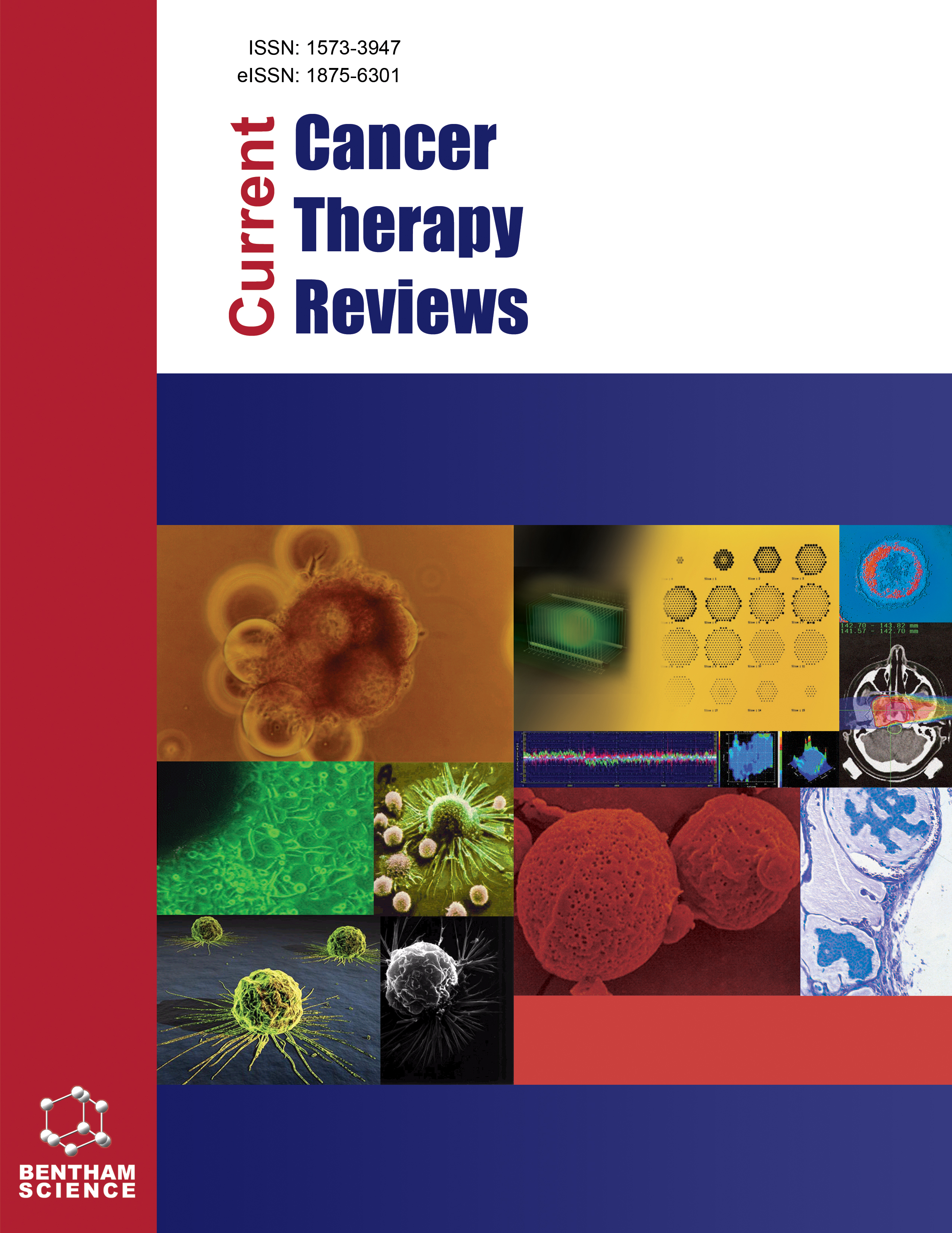- Home
- A-Z Publications
- Current Cancer Therapy Reviews
- Previous Issues
- Volume 2, Issue 3, 2006
Current Cancer Therapy Reviews - Volume 2, Issue 3, 2006
Volume 2, Issue 3, 2006
-
-
Biological Basis of Novel Therapies for Myelodysplastic Syndrome
More LessAuthors: Eyal C. Attar and Karen K. BallenMyelodysplastic syndrome (MDS) represents a group of malignant clonal disorders characterized by ineffective hematopoiesis and an accumulation of hematopoietic precursors in the bone marrow, frequently resulting in transformation to acute leukemia and death. However, recent understanding of MDS pathophysiology has provided novel treatment approaches with pharmacologic agents capable of manipulating p Read More
-
-
-
Current Treatment of Relapsed Ovarian Carcinoma
More LessAuthors: Aristotle Bamias, Alexandros Rodolakis and Meletios A. DimopoulosOvarian cancer is a leading cause of death from gynecological cancer. Although most patients will experience remission of their disease, following cytoreductive surgery and platinum (+ paclitaxel) chemotherapy, relapse will occur in about 80% of cases with FIGO stages III and IV disease. Treatment of recurrent ovarian cancer represents a challenge. Cure is rare but long-term survival can be achieved in a significant propo Read More
-
-
-
Lenalidomide: Cancer Therapy via Antiangiogenesis and Immunomodulation
More LessAuthors: Tanyifor M. Tohny, Jurgen Venitz, Alex Sparreboom and William D. FiggOur rapidly expanding understanding of the molecular pathogenesis of a variety of cancers is providing new molecular targets for drug development; specifically, immunomodulatory and antiangiogenic agents are poised to become essential in novel cancer therapeutics. Rationale for the development of such therapies rest in the observation that these immune and angiogenic targets (e.g. TNF-α , VEGF, IL-6, IL-2 a Read More
-
-
-
A Role for Tumor Suppressor Protein p53 in the Fidelity of DNA Synthesis and Resistance Towards Nucleoside Analogs
More LessAuthors: Mary Bakhanashvili and Galia RahavThe tumor suppressor protein p53 plays an important role in maintaining genomic integrity. p53 possesses an intrinsic 3'→ 5' exonuclease activity. The presence of exonuclease activity has been implicated in the prevention of mutator phenotype and in acquired resistance to chemotherapeutic agents. p53 may act as proofreading exonuclease for DNA polymerases during DNA replication. The recombinant wild-type p53 can pro Read More
-
-
-
Molecular Profiles of Sentinel and Non-Sentinel Lymph Nodes in Breast Cancer Progression and Prognosis
More LessSentinel lymph nodes (SLN) receive lymphatic drainage from the primary tumour and have been regarded as sensitive and reliable indicators of disease progression. It has been postulated that absence of metastatic tumour in SLN might obviate the exigency of axillary clearance and avoid the associated morbidity. But debate continues about the need for complete axillary dissection in SLN positive breast cancer patients, an Read More
-
-
-
Testicular Germ Cell Tumors: A Paradigm for the Successful Treatment of Solid Tumor Stem Cells
More LessAuthors: Caryl J. Giuliano, Sarah J. Freemantle and Michael J. SpinellaTreatment of testicular germ cell tumors (TGCTs) has been a success primarily due to the exquisite responsiveness of this solid tumor to cisplatin-based therapy. Despite the promise of cure for the majority of TGCT patients, the effectiveness of therapy for some patients is limited by toxicity and the problem of resistance. There is compelling rationale to further understand the biology of TGCTs in order to better treat other sol Read More
-
-
-
Cancer Therapy-Induced Residual Bone Marrow Injury: Mechanisms of Induction and Implication for Therapy
More LessAuthors: Yong Wang, Virginia Probin and Daohong ZhouBone marrow (BM) suppression is an important dose-limiting side effect of chemotherapy and radiotherapy for cancer. Although acute myelosuppression is an immediate concern for patients undergoing cancer therapy, its management has been improved significantly in recent years by the use of various hematopoietic growth factors. However, many patients receiving chemotherapy and/or ionizing radiation (IR Read More
-
Volumes & issues
-
Volume 21 (2025)
-
Volume 20 (2024)
-
Volume 19 (2023)
-
Volume 18 (2022)
-
Volume 17 (2021)
-
Volume 16 (2020)
-
Volume 15 (2019)
-
Volume 14 (2018)
-
Volume 13 (2017)
-
Volume 12 (2016)
-
Volume 11 (2015)
-
Volume 10 (2014)
-
Volume 9 (2013)
-
Volume 8 (2012)
-
Volume 7 (2011)
-
Volume 6 (2010)
-
Volume 5 (2009)
-
Volume 4 (2008)
-
Volume 3 (2007)
-
Volume 2 (2006)
-
Volume 1 (2005)
Most Read This Month
Article
content/journals/cctr
Journal
10
5
false
en


